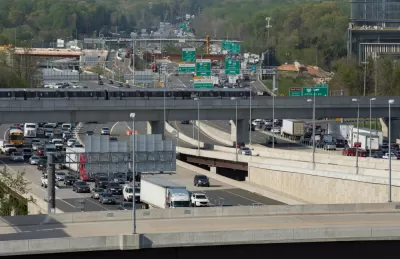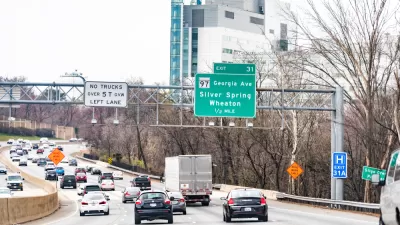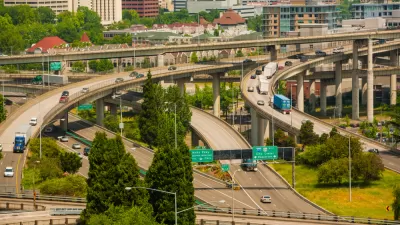Transportation is the largest source of greenhouse gas emissions in the D.C. region—and the rest of the country. The D.C. region is committing to drastic actions to change their ways, however.

“Leaders from around the D.C. area voted Wednesday to adopt aggressive greenhouse gas reduction goals for the transportation sector, pledging to cut carbon emissions by 50% by 2030,” reports Jacob Fenston for DCist.
The vote by the National Capital Region Transportation Planning Board (TPB), part of the Metropolitan Washington Council of Governments, came as somewhat of a surprise, according to Fenston. “The board was set to vote on a much more modest proposal to cut emissions by 32%, which planners said was realistic yet still ambitious. That goal was upped to 50% through an amendment put forward by Montgomery County.”
According to the article, TPB's ambitious targets will be aided by several initiatives ready to contribute to the cause:
- “making half of new cars electric or fueled by other carbon-free sources by 2030;
- “building an electric vehicle charging network;
- “completing a regional trail network to boost biking and walking;
- “building 77,000 new homes around transit hubs; and cutting travel times on bus and rail.”
This editor should note, however, the evidence that electric cars aren’t the emissions panacea some hope.
“Other strategies to be further explored include changes that could be more expensive or politically unpalatable, such as a tax on vehicle miles traveled, making all public transit free, and charging a fee to drive in downtown D.C. and other activity centers,” according to Fenston.
According to the source article, linked below, advocates are celebrating the adoption of the emission reductions targets as a historic step in the fight against climate change.
FULL STORY: D.C. Region Will Now Consider Climate Impacts In Transportation Planning, Aiming To Cut Emissions In Half

Alabama: Trump Terminates Settlements for Black Communities Harmed By Raw Sewage
Trump deemed the landmark civil rights agreement “illegal DEI and environmental justice policy.”

Study: Maui’s Plan to Convert Vacation Rentals to Long-Term Housing Could Cause Nearly $1 Billion Economic Loss
The plan would reduce visitor accommodation by 25% resulting in 1,900 jobs lost.

Why Should We Subsidize Public Transportation?
Many public transit agencies face financial stress due to rising costs, declining fare revenue, and declining subsidies. Transit advocates must provide a strong business case for increasing public transit funding.

Paris Bike Boom Leads to Steep Drop in Air Pollution
The French city’s air quality has improved dramatically in the past 20 years, coinciding with a growth in cycling.

Why Housing Costs More to Build in California Than in Texas
Hard costs like labor and materials combined with ‘soft’ costs such as permitting make building in the San Francisco Bay Area almost three times as costly as in Texas cities.

San Diego County Sees a Rise in Urban Coyotes
San Diego County experiences a rise in urban coyotes, as sightings become prevalent throughout its urban neighbourhoods and surrounding areas.
Urban Design for Planners 1: Software Tools
This six-course series explores essential urban design concepts using open source software and equips planners with the tools they need to participate fully in the urban design process.
Planning for Universal Design
Learn the tools for implementing Universal Design in planning regulations.
Smith Gee Studio
Alamo Area Metropolitan Planning Organization
City of Santa Clarita
Institute for Housing and Urban Development Studies (IHS)
City of Grandview
Harvard GSD Executive Education
Toledo-Lucas County Plan Commissions
Salt Lake City
NYU Wagner Graduate School of Public Service





























